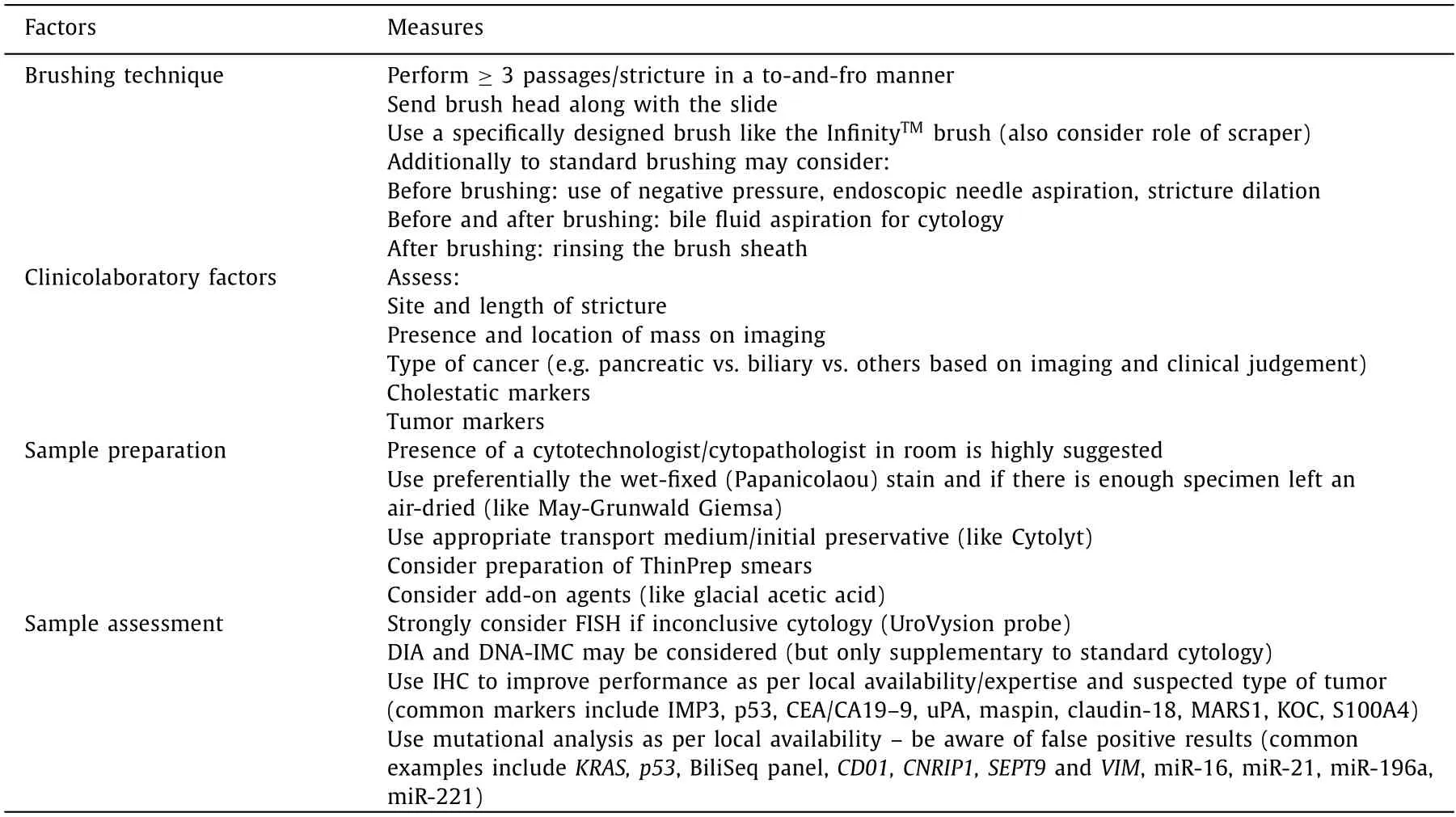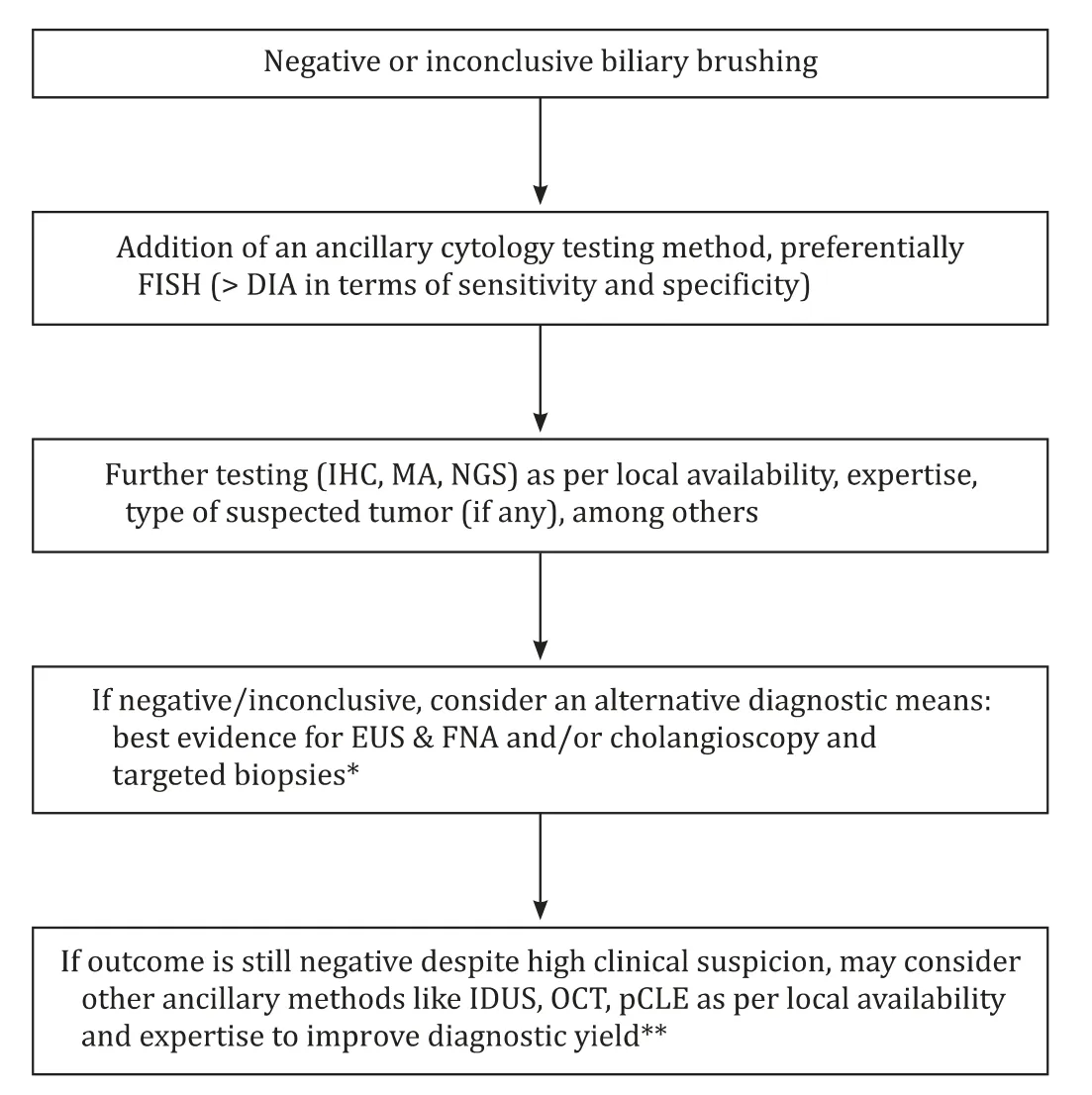Practical guide to improving diagnostic sensitivity of bile duct brushings
Ioannis C Varbobitis ,Jonathan C Booth,Cameron L Griffiths,Nishchay Chandra
Department of Gastroenterology, Royal Berkshire Hospital, Reading RG1 5AN, UK
Despite recent advances in hepatopancreatobiliary (HPB) endoscopy,pancreatobiliary (PB) tract brushing remains the first diagnostic approach in cases of indeterminate PB strictures.An accurate cytological diagnosis is critical to establishing an early and definite diagnosis before proceeding to aggressive chemotherapy regimens or major operations like a Whipple’s procedure.Nevertheless,the value of PB brushings is compromised by the fact that they have been historically characterized by low and variable sensitivity [1] and considerable intra-and inter-observer variability [2] .In an attempt to achieve a more objective interpretation of brushing specimens,cytological assessments have employed standardized reporting systems such as the classification proposed by the Papanicolaou Society of Cytopathology [3] which suggests classifying the reports into the following sub-categories:non-diagnostic,negative,atypical,neoplastic (benign or other),suspicious and positive.Nevertheless,a significant proportion of cytological assessments will still be compromised by inherent challenges in several components involved in the processes of sampling,preparation,examination and interpretation of brush smears.
In this study,we sought to provide a practical guide (Table 1)to improving the diagnostic sensitivity of biliary brushings by presenting our single institution experience [4] and reviewing the literature.We are also suggesting a diagnostic approach (Fig.1)which could help improve the overall diagnostic yield following an inconclusive cytology result.

Table 1 Practical guide to improving brushing sensitivity based on risk factors identified through the literature and our single institution experience.
To begin with,one of the commonest causes for an inconclusive or false negative brush cytology is a scant or poorly-reserved material.At our institution,we tried to optimize our brushing sensitivity by following a standard brushing technique including at least 3 passages through the stricture,sending the brush head along with the slide and brushing the stricture in a to-and-fro manner,which is a well-established means of cytology sampling [5] .The minimum number of 3 passages per stricture was chosen after our cytologist’s advice,as there are no official recommendations or guidelines.However,relevant studies have shown that an increased number of passages (5 to 10) can be associated with remarkably high sensitivity,up to 80.4% [6,7].On the other hand,use of less than three passages per brushing procedure may be associated with considerably lower sensitivity [8] .
Another factor which seems to play an important role in the quality of cytology material is the type of brush used for sampling.The InfinityTMcytology brush is a 9 Fr,specifically designed brush which employs a nitinol drive wire,detachable handle with salvage cytology capability and stiffer,wider-spaced bristles.Direct comparison studies have almost consistently shown increased number of cell clusters and higher sensitivity (up to 78%) with the InfinityTMcompared to those with conventional brushes [9,10].Use of an endoscopic scraper instead of a cytology brush has been also reported in the literature [11] ;initial results are promising,but more and well-designed studies are needed.
In addition to the above,other techniques that may increase the diagnostic yield of bile tract cytology include,among others,bile fluid aspiration and analysis [6],pre-dilatation of the stricture [12],use of negative pressure during brushing and rinsing the brush head after the procedure.However,these techniques should be always combined with standard brushings and should not be used on their own [6] .
Apart from using an adequate brushing technique and choosing the right equipment,it is important for the endoscopist/clinician to have assessed the anatomical considerations of the stricture and other relevant clinico-laboratory factors before the procedure.A longer stricture seems to be beneficial in that it is more likely to provide a positive cytological diagnosis [13],but the relationship between brushing sensitivity and the location of the stricture is less clear.At our HPB department [4],we found that a stricture involving the distal common bile duct (defined as the distal third of the extrahepatic bile duct) was significantly associated with increased biliary brushing sensitivity.We believe that distal common bile duct strictures are technically less-challenging and are also more likely to be caused by direct tumor involvement compared to proximal strictures,which in many cases necessitate the use of ancillary methods like direct cholangioscopy or endoscopic ultrasound (EUS).
Other factors which may be associated with brushing sensitivity include the type of malignancy,if any,and the presence of a mass lesion on a pre-procedural scan.The type of malignancy can be suspected before the procedure,based on available imaging and clinical information.Overall,brushing sensitivity appears to be higher for pancreatic cancer-related strictures,but in the majority of studies these differences have been non-significant [4,13].It should be noted that cholangiocarcinomas are often associatedwith intense desmoplastic reaction and resultant fibrosis which may well undermine the diagnostic yield of the cytology sample.

Fig.1.Diagnostic approach which may be followed following an initial negative or inconclusive cytology outcome
On the other hand,the presence of a mass lesion on a preprocedural scan seems to be associated with a higher chance for positive cytology [14] and this association may become stronger with an increasing diameter of the mass [13] .At our department,we found that a mass in the pancreatic head could be a prognostic factor for a positive cytology outcome.However,when we included masses arising from the uncinate process of the pancreas,the relationship with brushing sensitivity was no more significant [4] .This indicates that a mass being in direct contact with the bile duct may increase the diagnostic sensitivity of biliary brushings.
Laboratory parameters may predict the diagnostic outcome of biliary brushings and it has been shown that increased bilirubin levels,on the one hand,and carbohydrate antigen 19-9 (CA19-9)and carcinoembryonic antigen (CEA) levels,on the other,can be associated with enhanced brushing sensitivity [15] .However,no clear association has been demonstrated with the age and sex of the patients and other clinical parameters.
A critical step in increasing biliary brushing sensitivity is the proper preparation and process of the cytology sample.It is widely accepted that onsite cytotechnology evaluation can improve the accuracy of bile duct cytology.However,this may not be possible in most cases.Also,different centers may use different staining methods.In our center,our prepared slides were stained with the Papanicolaou (wet-fixed slide) and May-Grunwald Giemsa (MGG)(air-dried slide) stains,two of the most widely used stains in cytology [4] .The Papanicolaou stain should be asinequanondue to its high accuracy in demonstrating nuclear details and should be the first choice.If the material is adequate,a second stain on airdried slides can be used to further enhance the diagnostic yield.
In addition to standard cytology,liquid-based cytology has been shown to increase the diagnostic yield of the cytology samples and the overall sensitivity.A typical and well-studied example is the ThinPrep method,where the cytology sample is initially removed from the preservative vial and undergoes cellular material extraction and centrifugation.Then,the final preparation is smeared on a ThinPrep slide in a vial with Preservcyt solution.The ThinPrep technique can increase the adequacy of the cellular sample providing better preservation and cytological detail.In clinical practice,this has invariably been associated with increased diagnostic sensitivity [16] .
Finally,several studies have examined the role of auxiliary laboratory-based techniques including,without being limited to,advanced imaging,gene expression profiling and DNA analysis in improving the diagnostic yield and sensitivity of the cytological examination [17-19] .Digital image analysis (DIA) is an image-based technique for DNA ploidy analysis.It should not be used alone as it is characterized by low sensitivity and specificity.However,available evidence shows that it can significantly improve the diagnostic yield when added to standard cytology [17] .Therefore,it has been suggested that it could help discriminate among patients with atypical or suspicious pathology.Another digital imagingbased technique,DNA image cytometry (DNA-IMC) has also been shown to increase both the specificity and positive predictive value when combined with routine cytology [20] .
数据显示,今年前10个月,涉及河北销售公司95504的有效投诉仅为10起,同比减少72起,降幅88%。其中,有3个月实现零投诉,客户回访满意度均为100%,并列板块第一名。
Fluorescentinsituhybridization (FISH) is a technique aimed to detect chromosomal alterations by the use of fluorescently labeled DNA probes.It is a well-studied and well-established means of increasing sensitivity during evaluation of cytological samples.Features like chromosomal aneuploidy,trisomy or polysomy are commonly found in samples of PB malignancies and can be combined with certain structural variations,such as the9p21deletion identified through the UroVysion probe set,in order to further increase the diagnostic yield of the cytopathology assessment [21] .
Immunohistochemistry (IHC) utilizes antibodies which selectively bind and thus identify certain antigens (proteins) in cells of a tissue section.Several antigens have been shown to increase the overall sensitivity when added to standard cytology (Table 1).Similar to IHC,PCR-based mutational profiling can increase the overall brushing sensitivity,especially when combined with other methods like FISH.Mutations in theKRASandp53genes can increase sensitivity to considerably high levels (up to 86% -100%),especially when combined with other methods [22] .However,their use may be limited in cases like chronic pancreatitis,where sensitivity is increased at the expense of decreased specificity.Next generation sequencing (NGS) is an advanced DNA sequencing technology which has been effectively used with standard cytology and certain NGS gene panels such as the 28-gene NGS panel BiliSeq have shown promising results (Table 1).
Despite the increasing use of advanced techniques like cholangioscopy and EUS-fine needle aspiration,PB brushings are still routinely used as a first diagnostic approach due to their availability,simplicity,safety and low cost.More importantly,they can still be comparable to biopsies when performed under the same conditions [23] .However,inconclusive results will always exist and in this case,it is important to proceed with diagnostic means which should be both time-saving and effective.By following an appropriate diagnostic approach,cases of diagnostic uncertainty would be minimized and patients would have the best chances to receive an effective treatment early.
Acknowledgments
None.
CRediTauthorshipcontributionstatement
Funding
None.
Ethicalapproval
Not needed.
Competinginterest
No benefits in any form have been received or will be received from a commercial party related directly or indirectly to the subject of this article.
 Hepatobiliary & Pancreatic Diseases International2021年4期
Hepatobiliary & Pancreatic Diseases International2021年4期
- Hepatobiliary & Pancreatic Diseases International的其它文章
- Recurrence and survival following microwave,radiofrequency ablation,and hepatic resection of colorectal liver metastases:A systematic review and network meta-analysis
- Mitochondria:A critical hub for hepatic stellate cells activation during chronic liver diseases
- Symptomatic Val122del mutated hereditary transthyretin amyloidosis:Need for early diagnosis and prioritization for heart and liver transplantation
- The growth rate of hepatocellular carcinoma is different with different TNM stages at diagnosis
- Overexpression of anillin is related to poor prognosis in patients with hepatocellular carcinoma
- Micro-positron emission tomography imaging of angiogenesis based on 18 F-RGD for assessing liver metastasis of colorectal cancer
